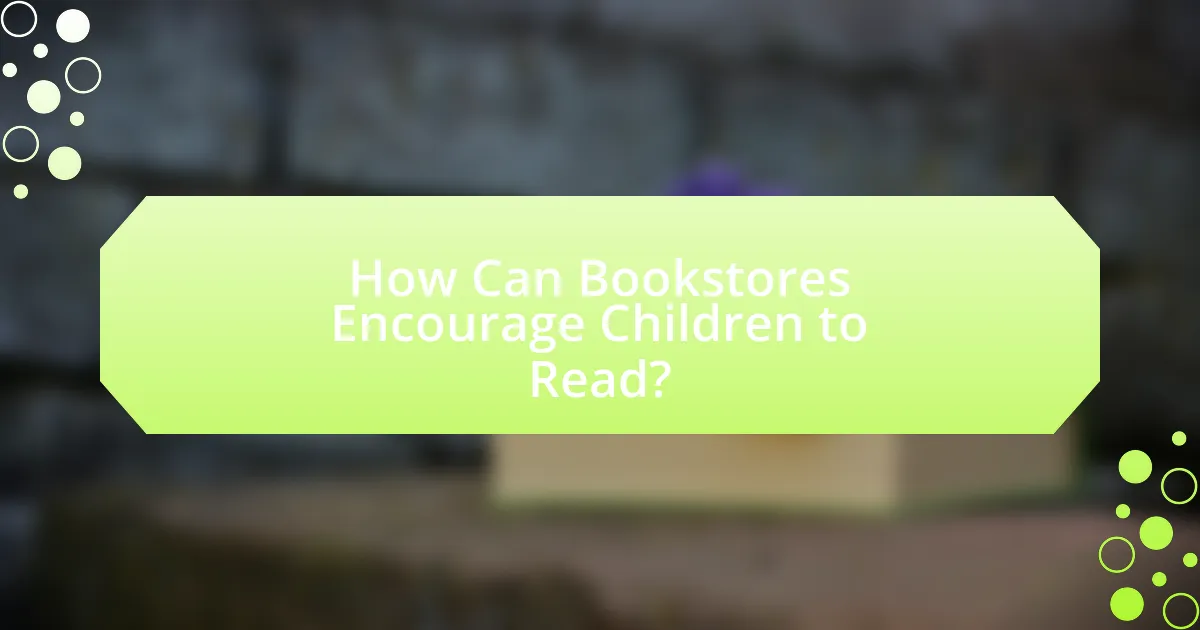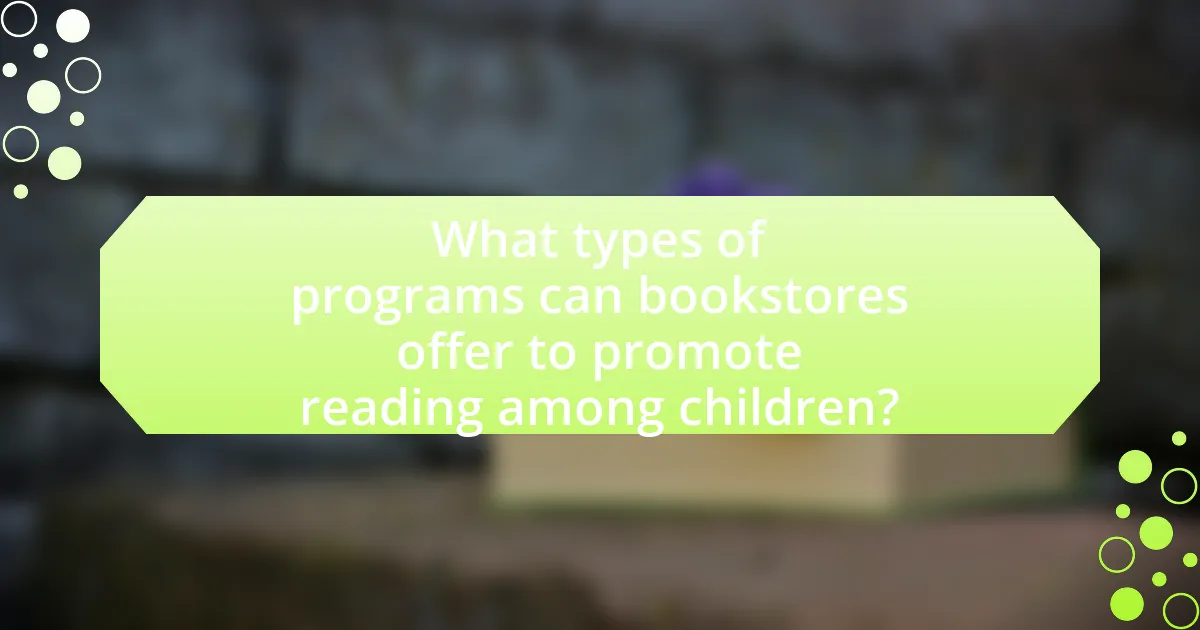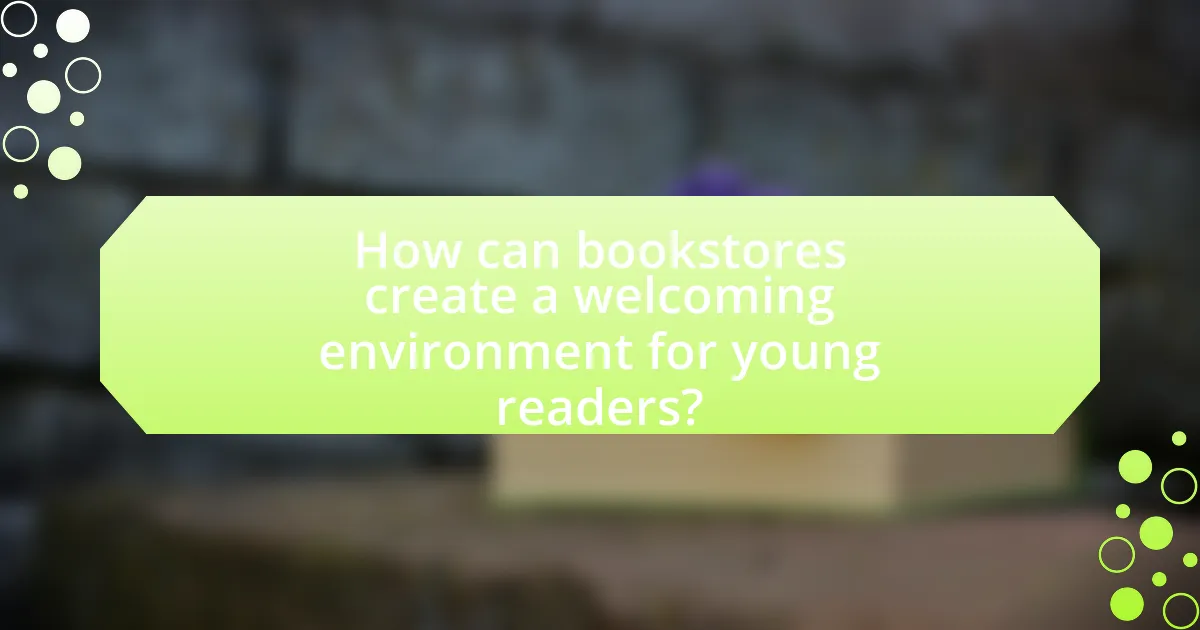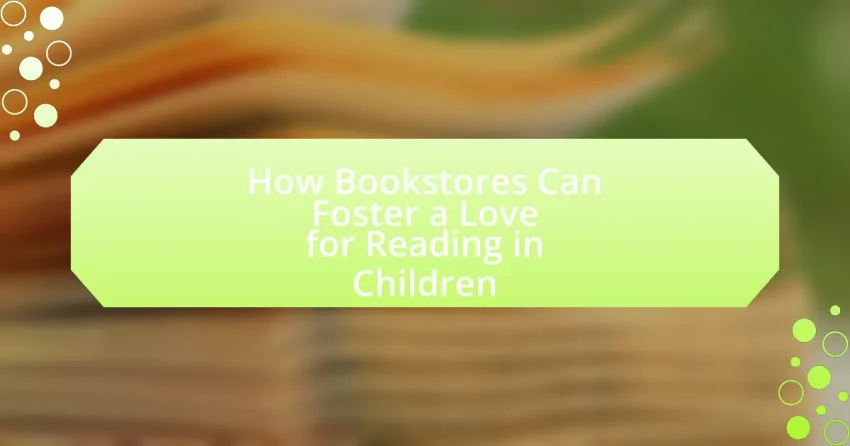The article focuses on how bookstores can foster a love for reading in children by creating engaging environments and implementing various strategies. Key methods include hosting storytime sessions, interactive reading programs, and themed events that captivate young audiences. Additionally, the article discusses the importance of early exposure to books, the role of reading clubs, and the impact of technology in enhancing children’s reading experiences. By prioritizing children’s literacy development through tailored programs and inviting spaces, bookstores can significantly contribute to nurturing a lifelong passion for reading among young readers.

How Can Bookstores Encourage Children to Read?
Bookstores can encourage children to read by creating engaging environments that promote literacy and provide access to a diverse range of books. For instance, hosting regular storytime sessions can captivate young audiences and introduce them to new stories, fostering a love for reading. Additionally, offering interactive reading programs, such as book clubs tailored for different age groups, can enhance children’s reading experiences and encourage peer discussions about books. Research indicates that children who participate in reading programs are more likely to develop positive attitudes toward reading, as seen in studies conducted by the National Literacy Trust, which found that children who engage in reading activities are more likely to read outside of school. By implementing these strategies, bookstores can effectively nurture a lifelong passion for reading among children.
What strategies can bookstores implement to attract young readers?
Bookstores can attract young readers by creating engaging events and interactive spaces. Hosting author readings, storytelling sessions, and book clubs specifically for children encourages participation and fosters a community around reading. Additionally, incorporating technology, such as interactive displays or reading apps, can enhance the experience and appeal to tech-savvy youth. Research indicates that children who participate in reading-related activities are more likely to develop a lifelong love for books, as evidenced by a study from the National Endowment for the Arts, which found that children who engage in reading activities are more likely to read for pleasure as they grow older.
How do interactive reading sessions impact children’s interest in books?
Interactive reading sessions significantly enhance children’s interest in books by actively engaging them in the storytelling process. These sessions often involve discussions, questions, and interactive elements that make the reading experience more dynamic and enjoyable. Research indicates that children who participate in interactive reading sessions show increased motivation to read and a greater appreciation for books, as evidenced by a study published in the Journal of Educational Psychology, which found that interactive reading can improve children’s vocabulary and comprehension skills, leading to a more profound interest in literature.
What role do themed events play in fostering a love for reading?
Themed events play a significant role in fostering a love for reading by creating immersive experiences that engage children’s imaginations and encourage participation. These events often incorporate storytelling, interactive activities, and themed decorations that resonate with popular books or genres, making reading more appealing. For instance, a Harry Potter-themed event can include wand-making workshops and potion-brewing activities, which not only attract children but also connect them to the narrative of the books. Research indicates that children who participate in such engaging activities are more likely to develop positive attitudes toward reading, as these events provide a social context that reinforces the enjoyment of books.
Why is it important for bookstores to focus on children’s reading?
It is important for bookstores to focus on children’s reading because early exposure to books fosters literacy development and a lifelong love for reading. Research indicates that children who engage with books at a young age develop better vocabulary, comprehension skills, and critical thinking abilities. According to a study by the National Institute for Literacy, children who are read to regularly are more likely to perform better academically throughout their schooling. By prioritizing children’s reading, bookstores not only support individual growth but also contribute to a more literate society.
How does early exposure to books influence a child’s development?
Early exposure to books significantly enhances a child’s cognitive, linguistic, and social development. Research indicates that children who are introduced to books at an early age exhibit improved vocabulary, better comprehension skills, and greater academic success later in life. A study published in the journal “Pediatrics” by Dr. Andrew Meltzoff and colleagues found that reading to children as young as six months old can lead to increased brain activity associated with language processing. Furthermore, early reading experiences foster a love for learning and curiosity, which are crucial for lifelong educational engagement.
What are the long-term benefits of cultivating a reading habit in children?
Cultivating a reading habit in children leads to enhanced cognitive development, improved academic performance, and better emotional intelligence over the long term. Research indicates that children who read regularly develop stronger language skills, which contribute to higher literacy rates and academic success. For instance, a study by the National Endowment for the Arts found that children who engage in reading activities are more likely to excel in school and achieve higher test scores. Additionally, reading fosters empathy and emotional understanding, as children learn to navigate diverse perspectives through stories. This emotional intelligence is crucial for social interactions and personal relationships throughout life.

What types of programs can bookstores offer to promote reading among children?
Bookstores can offer various programs to promote reading among children, including storytime sessions, reading challenges, book clubs, and author events. Storytime sessions engage children with interactive storytelling, fostering a love for narratives. Reading challenges incentivize children to read a certain number of books within a timeframe, often rewarding them with prizes, which can motivate consistent reading habits. Book clubs provide a platform for children to discuss books with peers, enhancing comprehension and critical thinking skills. Author events allow children to meet writers, sparking interest in the writing process and encouraging them to explore different genres. These programs have been shown to increase literacy rates and foster a lifelong love for reading among young audiences.
How can reading clubs enhance children’s engagement with books?
Reading clubs enhance children’s engagement with books by providing a social environment that encourages discussion and shared experiences around literature. This interaction fosters a sense of community and belonging, which can motivate children to read more. Research indicates that children who participate in reading groups show improved comprehension and a greater interest in reading, as they are exposed to diverse perspectives and ideas. For example, a study published in the Journal of Educational Psychology found that collaborative reading activities significantly increased students’ motivation and enjoyment of reading.
What age groups should bookstores target for reading clubs?
Bookstores should target age groups ranging from 6 to 18 years for reading clubs. This age range encompasses early elementary school children, middle school students, and high schoolers, all of whom are at critical developmental stages for fostering a love for reading. Research indicates that children aged 6 to 12 are particularly receptive to developing reading habits, as they are often encouraged by parents and educators to engage with books. Additionally, teenagers aged 13 to 18 benefit from reading clubs that promote critical thinking and discussion, which can enhance their comprehension and analytical skills. By focusing on these age groups, bookstores can effectively cultivate a lifelong passion for reading.
How can bookstores collaborate with schools to promote reading clubs?
Bookstores can collaborate with schools to promote reading clubs by organizing joint events such as author readings, book fairs, and workshops that engage students and educators. These events can provide students with direct access to authors and new books, fostering excitement around reading. For instance, a study by the National Endowment for the Arts found that exposure to literary events increases children’s interest in reading. Additionally, bookstores can offer discounts on books for reading club members, creating an incentive for participation. By partnering with schools to create tailored reading lists and providing resources for teachers, bookstores can further support the development of reading clubs, enhancing the overall reading culture within the school community.
What role do book recommendations play in encouraging children to read?
Book recommendations play a crucial role in encouraging children to read by guiding them toward age-appropriate and engaging literature. When children receive tailored suggestions, they are more likely to discover books that resonate with their interests and reading levels, which can enhance their motivation to read. Research indicates that children who receive personalized book recommendations are more inclined to develop a positive attitude toward reading, as these recommendations can introduce them to new genres and authors they might not explore independently. For instance, a study by the National Literacy Trust found that children who engage with recommended books show improved reading skills and increased enjoyment of reading activities.
How can bookstores curate age-appropriate book lists for children?
Bookstores can curate age-appropriate book lists for children by utilizing developmental guidelines and age-specific reading levels. Research indicates that children’s cognitive and emotional development varies significantly by age, which informs the selection of books that are suitable for different age groups. For instance, the American Library Association provides resources that categorize books based on age and reading ability, ensuring that selections align with children’s comprehension skills and interests. Additionally, bookstores can engage with educators and child development specialists to refine their lists, ensuring they reflect current educational standards and trends in children’s literature. This approach not only enhances the relevance of the book lists but also supports children’s growth and fosters a lifelong love for reading.
What impact do staff recommendations have on children’s reading choices?
Staff recommendations significantly influence children’s reading choices by guiding them toward age-appropriate and engaging literature. Research indicates that children are more likely to select books recommended by knowledgeable staff, as these recommendations provide a sense of trust and validation. For instance, a study published in the Journal of Research in Reading found that children who received staff recommendations showed a 30% increase in book selection compared to those who did not receive any guidance. This demonstrates that staff recommendations not only enhance children’s reading experiences but also encourage them to explore new genres and authors, ultimately fostering a lifelong love for reading.

How can bookstores create a welcoming environment for young readers?
Bookstores can create a welcoming environment for young readers by designing dedicated children’s spaces that are inviting and engaging. These spaces should include comfortable seating, colorful decor, and age-appropriate books that cater to various interests and reading levels. Research indicates that environments tailored for children, such as those with interactive displays and cozy reading nooks, significantly enhance their reading experience and encourage exploration. For instance, a study by the American Library Association found that children are more likely to engage with books in settings that feel safe and stimulating, which reinforces the importance of a thoughtfully designed space in fostering a love for reading.
What design elements can make bookstores more child-friendly?
Child-friendly bookstores can incorporate design elements such as dedicated children’s sections, interactive reading nooks, and colorful, engaging decor. Dedicated children’s sections provide a safe and inviting space for kids, often featuring lower shelves that allow easy access to books. Interactive reading nooks, equipped with comfortable seating and playful designs, encourage children to explore stories in a cozy environment. Colorful decor, including murals and themed displays, captures children’s attention and stimulates their imagination, making the bookstore a more appealing place for young readers. These elements collectively create an environment that fosters a love for reading in children by making the experience enjoyable and accessible.
How does the layout of a bookstore influence children’s reading habits?
The layout of a bookstore significantly influences children’s reading habits by creating an inviting and engaging environment that encourages exploration and interaction with books. A well-organized layout, featuring cozy reading nooks, child-friendly signage, and strategically placed displays, can attract children’s attention and stimulate their curiosity. Research indicates that children are more likely to engage with books when they are easily accessible and presented in a visually appealing manner, as evidenced by studies showing that interactive spaces in bookstores lead to increased time spent reading and a greater likelihood of selecting books. Additionally, layouts that incorporate thematic sections or genres can help children discover new interests, further enhancing their reading habits.
What types of seating arrangements are most inviting for children?
Seating arrangements that are most inviting for children include cozy, flexible spaces with soft seating options like bean bags, floor cushions, and small chairs. These arrangements create a comfortable and relaxed environment that encourages children to engage with books. Research indicates that children are more likely to read and explore literature in informal settings that allow for movement and social interaction, as highlighted in studies on child-friendly learning environments. Additionally, incorporating low tables and group seating fosters collaboration and discussion among peers, further enhancing their reading experience.
How can bookstores utilize technology to engage young readers?
Bookstores can utilize technology to engage young readers by implementing interactive e-books and gamified reading apps that make reading more appealing. These digital tools can provide immersive experiences, such as augmented reality features that bring stories to life, enhancing the reading experience. Research indicates that children are more likely to engage with reading materials that incorporate technology; for instance, a study by the Joan Ganz Cooney Center found that children who used interactive e-books showed increased comprehension and motivation to read. Additionally, bookstores can host virtual author events and online book clubs, allowing young readers to connect with authors and peers, further fostering a community around reading.
What digital tools can enhance the reading experience for children?
Digital tools that can enhance the reading experience for children include interactive e-books, reading apps, and audiobooks. Interactive e-books, such as those offered by platforms like Epic! and Raz-Kids, engage children with animations and quizzes that promote comprehension and retention. Reading apps, including Starfall and ABCmouse, provide gamified learning experiences that make reading enjoyable and accessible. Audiobooks, available through services like Audible and Libby, allow children to experience stories in a different format, fostering listening skills and imagination. Research indicates that children who engage with these digital tools show improved literacy skills and a greater interest in reading.
How can interactive apps complement traditional reading in bookstores?
Interactive apps can complement traditional reading in bookstores by enhancing engagement and providing interactive learning experiences. These apps can offer features such as augmented reality, which allows children to see characters come to life or explore story settings in a more immersive way. Research indicates that interactive reading experiences can improve comprehension and retention; for instance, a study published in the Journal of Educational Psychology found that children who engaged with interactive reading materials showed a 20% increase in comprehension compared to those who read traditional texts alone. By integrating these apps into the bookstore environment, children can enjoy a multi-faceted approach to reading that combines the tactile experience of physical books with the dynamic elements of technology.
What are some best practices for bookstores to foster a love for reading in children?
Bookstores can foster a love for reading in children by creating engaging environments that encourage exploration and interaction with books. Establishing dedicated children’s sections filled with age-appropriate literature allows young readers to discover stories that resonate with them. Hosting regular storytelling sessions and author events can further enhance children’s interest in reading by providing them with direct experiences related to the books. Additionally, offering reading challenges or reward programs incentivizes children to read more frequently, making reading a fun and rewarding activity. Research indicates that children who participate in reading programs show improved literacy skills and a greater enthusiasm for reading, highlighting the effectiveness of these practices in nurturing a lifelong love for books.
How can bookstores measure the success of their reading initiatives?
Bookstores can measure the success of their reading initiatives by tracking participation rates in events, sales of related books, and customer feedback. For instance, a bookstore can analyze attendance numbers at reading events or workshops to gauge interest and engagement levels. Additionally, monitoring sales data for children’s books before and after implementing reading initiatives can provide insights into the impact of these programs on purchasing behavior. Customer feedback, collected through surveys or informal conversations, can also reveal perceptions of the initiatives and their effectiveness in fostering a love for reading among children.
What feedback mechanisms can bookstores implement to improve their programs?
Bookstores can implement customer surveys, suggestion boxes, and focus groups as feedback mechanisms to improve their programs. Customer surveys can be distributed both online and in-store to gather insights on preferences and experiences, allowing bookstores to tailor their offerings to meet the needs of their audience. Suggestion boxes provide a simple way for customers to share ideas or concerns anonymously, fostering a sense of community involvement. Focus groups can facilitate in-depth discussions with selected customers, enabling bookstores to gain detailed feedback on specific programs or events. These methods have been shown to enhance customer satisfaction and engagement, ultimately leading to more effective programming that encourages a love for reading in children.
